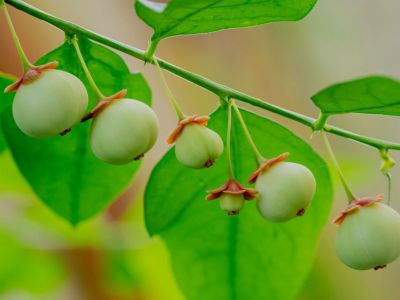What is Katuk?
Katuk (Sauropus androgynus) is a shrub, indigenous to Southeast Asia that is cultivated in Cambodia, Indonesia, Laos, Malaysia, the Philippines, Thailand, Vietnam, and India. It thrives in tropical climates in lowland rainforests where it grows between 4-6 feet (1 to 2 m.) tall. Additional Katuk plant info describes it as an upright bush with multiple stems and dark green, oval-shaped leaves. In tropical climates, the plant stays green year-round, but in cooler climes, the bush will likely lose leaves in the winter only to regrow in the spring. The shrub blooms in the summer and fall with small, flat, round, yellow to red flowers in the leaf axil followed by a purple fruit with tiny black seeds. It takes two Katuk shrubs to pollinate and produce fruit.
Is Katuk Edible?
You might be wondering about Katuk’s alternate name of Sweetleaf, which may also make one wonder if Katuk is edible. Yep, there is a premium market for the tender shoots, even the flowers, small fruit, and seeds of the Katuk. The flavor is said to be like that of a pea with a bit of a nutty flavor. It is eaten in Asia, both raw and cooked. The shrub is cultivated in shaded areas, irrigated frequently, and fertilized to produce rapidly growing tender tips that are similar to asparagus. The plant is highly nutritious with about half of its nutrition as protein! As well as being incredibly nutritious, Katuk has medicinal properties, one of which is to stimulate milk production in nursing mothers. A word of warning, excessive consumption of raw Katuk leaves or juices has led to chronic lung problems. However, it takes quite a lot of raw Katuk to cause any sort of problem and millions of people eat it every day with no ill effects.
Katuk Plant Info
Growing a Katuk shrub is relatively easy, provided you live in an area of moist, hot conditions or can mimic such conditions in a greenhouse. When growing a Katuk shrub, it will do best in a shaded area, just like the understory of the rainforest it is native to, but it will also do well in full sun provided you keep the soil damp. Katuk is easily propagated via cuttings set in water or put directly into the soil in a moist shady area. Apparently, the shrub can grow up to a foot (0.5 m.) a week in ideal conditions, although it has a tendency to flop over when it gets too tall. For this reason and to encourage tender new shoots, regular pruning is done by Asian cultivators. This shrub seems to be remarkably pest-free.
